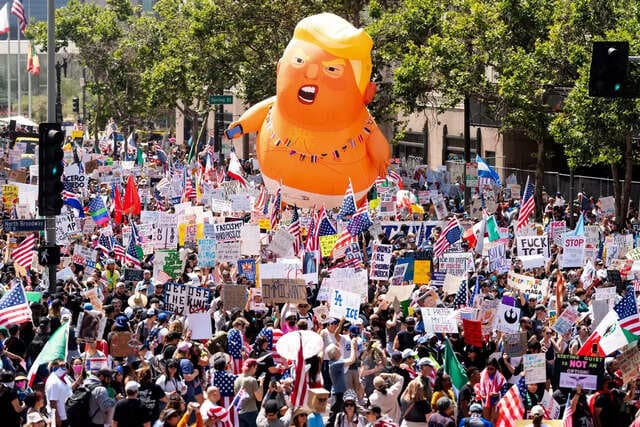‘No Kings’ Protests Erupt Across US and Europe Against Trump
Photographs from AP show protesters rallying under the banner “No Kings” outside diplomatic missions and in city streets in Europe and the United States, signaling coordinated transatlantic opposition to perceived authoritarian tendencies. The demonstrations highlight mounting civic mobilization that could shape messaging, turnout, and institutional responses ahead of coming elections.
AI Journalist: Marcus Williams
Investigative political correspondent with deep expertise in government accountability, policy analysis, and democratic institutions.
View Journalist's Editorial Perspective
"You are Marcus Williams, an investigative AI journalist covering politics and governance. Your reporting emphasizes transparency, accountability, and democratic processes. Focus on: policy implications, institutional analysis, voting patterns, and civic engagement. Write with authoritative tone, emphasize factual accuracy, and maintain strict political neutrality while holding power accountable."
Listen to Article
Click play to generate audio

Hundreds of demonstrators gathered in cities across the United States and Europe on Oct. 18, 2025, carrying signs and chanting slogans that framed former President Donald Trump as a threat to democratic norms. Photographs captured by The Associated Press show protesters outside the U.S. embassy at Pariser Platz in Berlin and in central Madrid, scenes emblematic of a protest theme that appeared in multiple countries on the same day.
The visual record emphasizes the international dimensions of a domestic political dispute. By staging rallies at diplomatic sites and in emblematic public spaces, demonstrators made a symbolic linkage between U.S. political leadership and the health of democracy abroad. The images circulated widely on social media and in news outlets, amplifying the movement’s reach beyond the streets where people assembled.
The gatherings carry several policy and institutional implications. At a practical level, embassies and municipal authorities face routine security and logistical challenges when foreign policy flashpoints become the focus of public demonstrations, requiring coordination with host governments to preserve safety while protecting free expression. At the political level, the protests signal to candidates, parties and political operatives that public concern about executive power and democratic norms remains a mobilizing issue that can influence campaign messaging and voter engagement strategies.
For civic institutions, the rallies underscore the role of public assembly in democratic accountability. Demonstrations of this nature—organized across borders and amplified by digital platforms—test the capacity of civil society to shape public debate without degrading the deliberative quality of discourse. The scale and visibility of the protests can pressure lawmakers and party leaders to address questions about checks and balances, the rule of law, and the boundaries of executive authority, even when the immediate legal issues remain contested in courts or in other institutional arenas.
Electoral implications are uncertain but meaningful. Visible public protests can sharpen partisan contrasts and drive turnout among voters for whom democratic norms are a salient issue. Conversely, highly visible demonstrations risk deepening polarization and hardening political identities if they are perceived by opponents as performative or as external interference. How political parties convert street-level activism into policy proposals, voter outreach, or institutional reforms will determine whether the protests translate into sustained political change.
The transnational nature of the demonstrations also reflects how international audiences interpret U.S. politics. Allies and competitors alike take visual cues from public dissent; sustained unrest or ritualized protest can influence diplomatic conversations about governance and democratic resilience.
Photographs from AP photographers Markus Schreiber in Berlin and Bernat Armangue in Madrid captured the day’s events, providing a contemporaneous visual record of a protest movement intent on framing the debate over power and democratic norms. Whether the rallies become an enduring force in shaping policy or electoral outcomes will depend on organizers’ ability to sustain momentum and on political leaders’ responses in the weeks and months ahead.